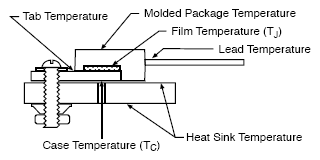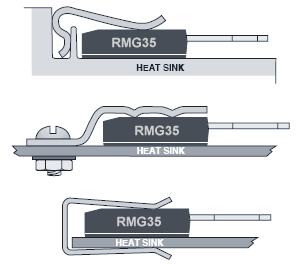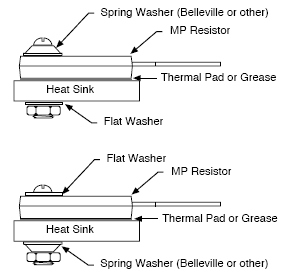Application Guide for Heat Sink Mountable Power Film Resistors
Understanding Temperature and Power Rating:

Figure 1 - Understanding Temperature and Power Rating
The maximum power rating of TO-style power film resistor is specified with the case temperature (TC) at 25°C. This is the same method proven and established by the power semiconductor industry. Case temperature is the temperature measured at the center of the resistor mounting surface which is in contact with the heat sink, while the resistor is under electrical load. Case temperature is different from the molded body temperature, the tab temperature, the lead temperature, or the ambient temperature (as shown in Figure 1).
Using case temperature we can determine the temperaure of the resistor film (TJ). This is crucial factor since early device failures are usually traced to excessive temperatures of the resistor film. Excessive film temperatures will cause a drift of the resistance value or reduced component life. Proper thermal design followed by temperature measurements to verify the design, and consistent mounting procedures will avoid these problems.
Assembly of Thermal Material:
Due to variations in the mating surfaces between the resistor package and the heat sink air voids are created. These voids will substantially degrade the performance of TO-Style device. Thus, it is important to use a thermal interface material to fill these air voids. Several materials are available to reduce thermal resistance between the resistor and heat sink surface.

Figure 2 - Spring Clips Mounting Technigques
- Thermal grease is a combination of thermally conductive particles combined with a fluid forming a grease-like consistency.
The fluid has typically been a silicone oil, however there are now very good "non-silicone" thermal greases.
Thermal grease has been used for many years and typically has among the lowest thermal resistances of all thermal materials available.
- Thermal pads, an alternative to thermal grease, are available from a number of manufacturers. These thermally conductive pads are available in sheet form or in pre-cut shapes designed for various standard packages such as the TO-220 and TO-247. Thermal pads are spongy materials and require uniform pressure and firm to perform properly.
Selection of Hardware Assembly:
Proper hardware is an extremely important consideration in a good thermal design. The hardware must maintain firm even pressure on the device, through thermal cycling, without deforming the heat sink or the device.
- Spring Clips are preferred by many designers in place of screw assembly for attaching DeMint TO-Style Power Resistors to the heat sink. These spring clips are available from several manufacturers which offers a number of standard springs and heat sinks specifically designed for clip mounting TO-220 and TO-247 packages. Spring clips offer many benefits for ease of assembly, but their biggest advantage is the consistent application of optimum force over the center of the power resistor (as shown in Figure 2).

Figure 3 - Screw and Washer Mounting Techniques
- Screw Mounting - Belleville or Conical Washers used with a screw are an effective method for attachment to a heat sink. A Belleville washer is a conical spring washer designed to maintain constant pressure over a wide range of deflection. The washers withstand long-term temperature cycling without variation in pressure. Figure 3 shows some typical hardware configurations for screw mounting a TO-Style package to a heat sink. Flat washers, star washers, and most split lock washers should not be used in place of Belleville washers since they do not provide a constant mounting pressure and may cause damage to the resistor.
Assembly Considerations:
- Avoid using this TO-Style family of power resistors for SMT assembly.
- Plastic mounting hardware that softens or creeps at high operating temperatures must be avoided.
- Never let the head of the screw contact the resistor. Use a flat washer or conical washer to evenly distribute the force.
- Avoid sheet metal screws which have a tendency to roll up the edges of the hole and create damaging burrs on the heat sink.
- Rivets are not recommended. With rivets it is difficult to maintain consistent pressure and they can easily damage plastic packages.
- Do not over-torque. If the screw is too tight, the package may crack or have a tendency to bow up at the end farthest from the screw (lead end). Pneumatic tools are not recommended.
General Information of Mountable Power Film Resistor
Compact TO-Style Resistors are Low Cost:
DeMint Electronics TO-Style power film heat sink mountable resistors, TO-220 and TO-247 Style Packages, are designed for intermediate power applications and combines performance with an economical price.
TO-220 Power Resistors, TO-247 Power Resistors RMG series are ultra precision and high power resistors encapsulated in the TO-220, TO-247 style power package. Power resistors are manufactured in 20W, 30W, 35W, 50W and 100W. Resistance element is electrically insulated from metal heat sink mounting tab. When properly mounted DeMint's RMG** TO220/TO247 packaged power resistors provide up to 50/100 watts of steady state power. These very low inductance resistors are ideal for many industrial applications: power supplies, power controls and inrush/bleeder resistors.
Download Entire Heat Sink Mountable TO-220, TO-247 Power Resistors Catalogue in PDF file (628KB).
Non-Inductive Design for High Frequency Applications:
DeMint's TO-Style Series satisfy demanding applications for accurate and stable power resistors housed in the convenient TO-Style case.
The resistance element is isolated from the mounting tab by an alumina ceramic layer, providing very low thermal resistance and ensuring high insulation resistance between terminals and tab.
These isolated resistor element are constructed and packaged in a high temperature plastic case with a single screw metal tab for easy mounting to the heat sink. The non-inductive design makes these products especially useful in high frequency and high speed pulse applications.
Pulse-Loading Applications as Snubber or Bleeder Resistors:
DeMint's TO-Style resistors are designed for use in pulse-loading applications, as bleeder or snubber resistors in switching power supplies, industrial power drives, medical, test equipment, high power equipment such as uninterruptible power supplies (UPS), and other power distribution and power conversion applications.
The Power Film Resistors use an optimized process of DeMint's thick film technology on an alumina substrate to achieve tolerances as low as ± 0.5 %, and up to ± 10 %. The Non-Inductive design and resistance values as low as 0.05 ohms are also ideal for current sensing applications.